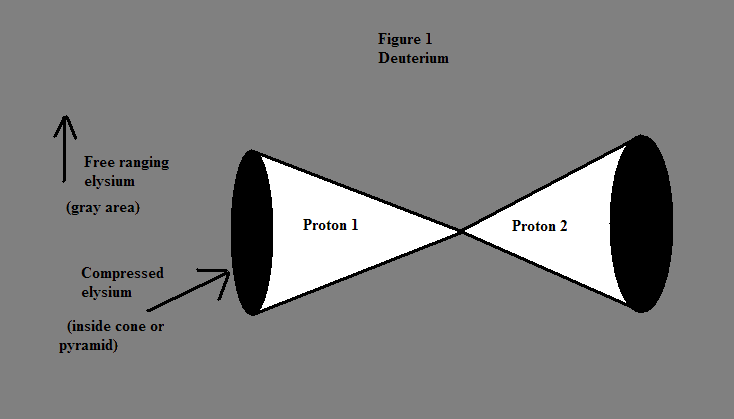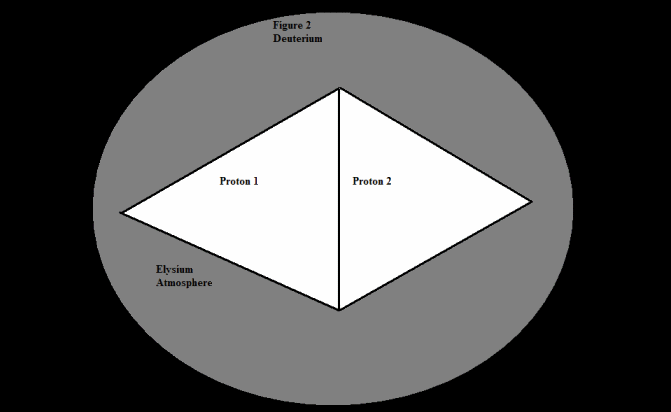- Thank you received: 0
Deep-Gas, Deep Hot Biosphere Theory
17 years 5 months ago #19796
by Stoat
Replied by Stoat on topic Reply from Robert Turner
In this case the m shell and n sub shell, of two electrons, overlap. Pauli is right but then the energy difference between the three options is small and will average out for reactions. How else can we explain the rare earths if we don't have shell overlaps.
Please Log in or Create an account to join the conversation.
- neilderosa
-
- Offline
- Platinum Member
-

Less
More
- Thank you received: 0
17 years 5 months ago #18277
by neilderosa
Replied by neilderosa on topic Reply from Neil DeRosa
<i><b>I am only speculating, but "electrons" emitted by an electron gun could be liquid droplets of Elysium which would have mass and velocity. Perhaps some collision mechanism within the electron gun causes then to be ejected from the gravity well of my proposed proton…
I have described a lone proton as always being naked. It is fully exposed to Elysium and gravitons. If one looks upon magnetism is being represented by focused gravitational flux and electricity as being represented by liquid Elysium, I think that is a complete picture. [Gregg]
And Mr Stoat, you want these electrons to share shells within another atom? For God's sake, man, we don't even know which electrons are willing to do this! [Gregg]</b></i>
Just following the story line, one might add—“or whether they even exist.”
I have described a lone proton as always being naked. It is fully exposed to Elysium and gravitons. If one looks upon magnetism is being represented by focused gravitational flux and electricity as being represented by liquid Elysium, I think that is a complete picture. [Gregg]
And Mr Stoat, you want these electrons to share shells within another atom? For God's sake, man, we don't even know which electrons are willing to do this! [Gregg]</b></i>
Just following the story line, one might add—“or whether they even exist.”
Please Log in or Create an account to join the conversation.
17 years 5 months ago #18278
by Gregg
Replied by Gregg on topic Reply from Gregg Wilson
<blockquote id="quote"><font size="2" face="Verdana, Arial, Helvetica" id="quote">quote:<hr height="1" noshade id="quote"><i>Originally posted by Stoat</i>
<br />In this case the m shell and n sub shell, of two electrons, overlap. Pauli is right but then the energy difference between the three options is small and will average out for reactions. How else can we explain the rare earths if we don't have shell overlaps.
<hr height="1" noshade id="quote"></blockquote id="quote"></font id="quote">
Pauling is right....about what?
The "rare earths" are simply "accidental" nuclei the same way oxygen or calcium or chromium are. They are nuclear fragments. How a rare earth nucleus forms has absolutely no relationship to chemical bonds, whether they are formed through electron "sharing" or any other mechanism.
There is an undercurrent to your thinking that these elements are "ordained" or "pre-destined". Nothing could be further from the truth. Every nucleus is simply a fragment of the radioactive breakdown of larger size nuclei which in turn is a radioactive breakdown of.....get the point?
It is the same problem with these "electron shells". Humans have brought them into existence only in a virtual sense. Reality neither cares or even knows about our "electron shells". I'm sure this stuff leads to "beautiful" equations but Reality doesn't care.
Gregg Wilson
<br />In this case the m shell and n sub shell, of two electrons, overlap. Pauli is right but then the energy difference between the three options is small and will average out for reactions. How else can we explain the rare earths if we don't have shell overlaps.
<hr height="1" noshade id="quote"></blockquote id="quote"></font id="quote">
Pauling is right....about what?
The "rare earths" are simply "accidental" nuclei the same way oxygen or calcium or chromium are. They are nuclear fragments. How a rare earth nucleus forms has absolutely no relationship to chemical bonds, whether they are formed through electron "sharing" or any other mechanism.
There is an undercurrent to your thinking that these elements are "ordained" or "pre-destined". Nothing could be further from the truth. Every nucleus is simply a fragment of the radioactive breakdown of larger size nuclei which in turn is a radioactive breakdown of.....get the point?
It is the same problem with these "electron shells". Humans have brought them into existence only in a virtual sense. Reality neither cares or even knows about our "electron shells". I'm sure this stuff leads to "beautiful" equations but Reality doesn't care.
Gregg Wilson
Please Log in or Create an account to join the conversation.
17 years 5 months ago #19798
by Jim
Replied by Jim on topic Reply from
Gregg, Would it make more sense to say every atom is made of two or protons/neutrons rather than being pieces of larger atoms?
Please Log in or Create an account to join the conversation.
17 years 5 months ago #18279
by Gregg
Replied by Gregg on topic Reply from Gregg Wilson
<blockquote id="quote"><font size="2" face="Verdana, Arial, Helvetica" id="quote">quote:<hr height="1" noshade id="quote"><i>Originally posted by Jim</i>
<br />Gregg, Would it make more sense to say every atom is made of two or protons/neutrons rather than being pieces of larger atoms?
<hr height="1" noshade id="quote"></blockquote id="quote"></font id="quote">
Based on a much previous posting, when protons and elysons have collected together as a single mass (mess) the elysium would still be largely vapor. Whenever two protons met, base to base, at a final closing velocity of zip, they would form deuterium. (A rare event - mainstream science got this part correct.) This deuterium would be the exact opposite of a Noble Gas - no Coulomb repulsion. The deuterium would be pushed together with Elysium that would now be a liquid. They would form a monstrous nucleus. Look carefully at a sunspot and the iris around it. Once the outer atmosphere of a star has been exhausted of elysons and protons, the star would shrink inward. This would leave the new born nuclear planet in open space. It would no longer have the protection - by the embronic, liquid Elysium - against collisions by other protons, etc. This nuclear mass would undergo radioactive decay on its surface. This breakdown would lead to the formation of all elements, except hydrogen, in a random manner. Once a "small" nuclear mass has acquired, by sheer chance, enough open base protons on its surface, it would stop decaying and be a stable isotope of some element. (Because open base protons would again have the Coulomb repulsion of vaporizing Elysium - and would, thus, have protection against collisions.) The whole process is entirely random. What you see is what you get.
We have organized a Periodic Table, which is a useful tool for human thinking. But Reality does not care about it or is even aware of it. We humans cannot <b>metaphysically</b> force Reality to match our models.
Gregg Wilson
<br />Gregg, Would it make more sense to say every atom is made of two or protons/neutrons rather than being pieces of larger atoms?
<hr height="1" noshade id="quote"></blockquote id="quote"></font id="quote">
Based on a much previous posting, when protons and elysons have collected together as a single mass (mess) the elysium would still be largely vapor. Whenever two protons met, base to base, at a final closing velocity of zip, they would form deuterium. (A rare event - mainstream science got this part correct.) This deuterium would be the exact opposite of a Noble Gas - no Coulomb repulsion. The deuterium would be pushed together with Elysium that would now be a liquid. They would form a monstrous nucleus. Look carefully at a sunspot and the iris around it. Once the outer atmosphere of a star has been exhausted of elysons and protons, the star would shrink inward. This would leave the new born nuclear planet in open space. It would no longer have the protection - by the embronic, liquid Elysium - against collisions by other protons, etc. This nuclear mass would undergo radioactive decay on its surface. This breakdown would lead to the formation of all elements, except hydrogen, in a random manner. Once a "small" nuclear mass has acquired, by sheer chance, enough open base protons on its surface, it would stop decaying and be a stable isotope of some element. (Because open base protons would again have the Coulomb repulsion of vaporizing Elysium - and would, thus, have protection against collisions.) The whole process is entirely random. What you see is what you get.
We have organized a Periodic Table, which is a useful tool for human thinking. But Reality does not care about it or is even aware of it. We humans cannot <b>metaphysically</b> force Reality to match our models.
Gregg Wilson
Please Log in or Create an account to join the conversation.
- neilderosa
-
- Offline
- Platinum Member
-

Less
More
- Thank you received: 0
17 years 5 months ago #18280
by neilderosa
Replied by neilderosa on topic Reply from Neil DeRosa
<blockquote id="quote"><font size="2" face="Verdana, Arial, Helvetica" id="quote">quote:<hr height="1" noshade id="quote">Based on a much previous posting, when protons and elysons have collected together as a single mass (mess) the elysium would still be largely vapor. Whenever two protons met, base to base, at a final closing velocity of zip, they would form deuterium. (A rare event - mainstream science got this part correct.) This deuterium would be the exact opposite of a Noble Gas - no Coulomb repulsion. The deuterium would be pushed together with Elysium that would now be a liquid. They would form a monstrous nucleus. [Gregg]<hr height="1" noshade id="quote"></blockquote id="quote"></font id="quote">
Gregg, Do either of these two illustrations have any resemblance to what you are describing?
Gregg, Do either of these two illustrations have any resemblance to what you are describing?
Please Log in or Create an account to join the conversation.
Time to create page: 0.475 seconds


